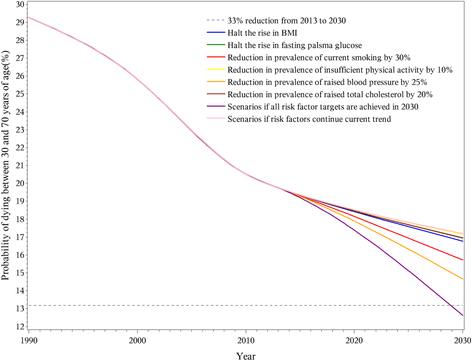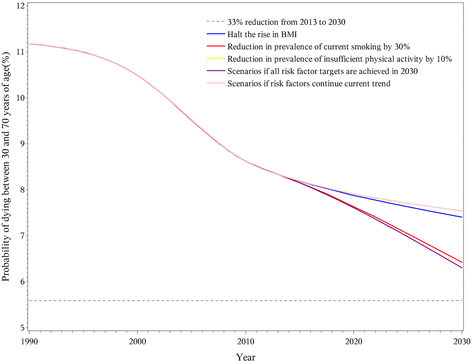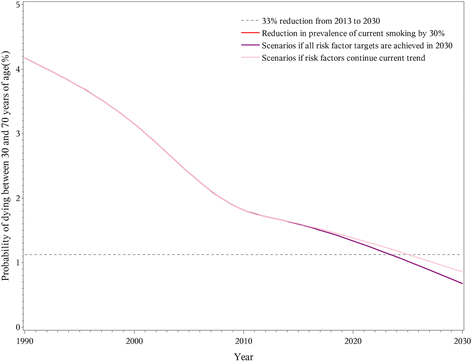Can China achieve a one-third reduction in premature mortality from non-communicable diseases by 2030?
- PMID: 28693510
- PMCID: PMC5504650
- DOI: 10.1186/s12916-017-0894-5
Can China achieve a one-third reduction in premature mortality from non-communicable diseases by 2030?
Abstract
Background: The United Nation's Sustainable Development Goals for 2030 include reducing premature mortality from non-communicable diseases (NCDs) by one third. To assess the feasibility of this goal in China, we projected premature mortality in 2030 of NCDs under different risk factor reduction scenarios.
Methods: We used China results from the Global Burden of Disease Study 2013 as empirical data for projections. Deaths between 1990 and 2013 for cardiovascular disease (CVD), diabetes, chronic respiratory disease, cancer, and other NCDs were extracted, along with population numbers. We disaggregated deaths into parts attributable and unattributable to high systolic blood pressure (SBP), smoking, high body mass index (BMI), high total cholesterol, physical inactivity, and high fasting glucose. Risk factor exposure and deaths by NCD category were projected to 2030. Eight simulated scenarios were also constructed to explore how premature mortality will be affected if the World Health Organization's targets for risk factors reduction are achieved by 2030.
Results: If current trends for each risk factor continued to 2030, the total premature deaths from NCDs would increase from 3.11 million to 3.52 million, but the premature mortality rate would decrease by 13.1%. In the combined scenario in which all risk factor reduction targets are achieved, nearly one million deaths among persons 30 to 70 years old due to NCDs would be avoided, and the one-third reduction goal would be achieved for all NCDs combined. More specifically, the goal would be achieved for CVD and chronic respiratory diseases, but not for cancer and diabetes. Reduction in the prevalence of high SBP, smoking, and high BMI played an important role in achieving the goals.
Conclusions: Reaching the goal of a one-third reduction in premature mortality from NCDs is possible by 2030 if certain targets for risk factor intervention are reached, but more efforts are required to achieve risk factor reduction.
Keywords: Chronic disease; Forecasting; Mortality, Premature; Risk factors.
Conflict of interest statement
Ethics approval and consent to participate
As all data was abstracted from the results from the GBD 2013 study, the consent to publication is not applicable. The Ethnic committee at the Chinese Center for Disease Control and Prevention approved the study.
Consent for publication
No individual data is presented, and consent to publication is therefore not applicable.
Competing interests
All authors declare that they have no competing interests.
Publisher’s Note
Springer Nature remains neutral with regard to jurisdictional claims in published maps and institutional affiliations.
Figures





References
MeSH terms
LinkOut - more resources
Full Text Sources
Other Literature Sources

